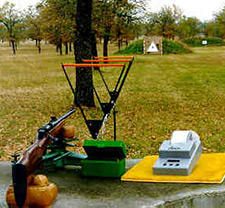Home | Glossary | Resources | Help | Contact Us | Course Map
Archival Notice
This is an archive page that is no longer being updated. It may contain outdated information and links may no longer function as originally intended.
Muzzle Velocity of Bullets
It may be necessary to measure and document the muzzle velocity of a fired bullet using a scientific and reproducible technique. In this measurement, a chronograph functions as a kind of electronic stopwatch for timing the speed of a bullet in flight (usually in feet per second). The chronograph is useful for shooting reconstructions, short distance bullet path determinations, and long distance trajectory analyses.
Chronographs
Chronographs are designed to sense the passage of a bullet past two sensors separated by a known distance, typically two to four feet. The sensors react to a change in light level as a bullet passes through. These sensors are referred to as screens or skyscreens and establish the known distance by their placement on a bar or rail. The shooter fires through the v-shaped arms of the sensors. Depending on the manufacturers recommendation, the distance from the muzzle to the first sensor is normally eight to fifteen feet. This prevents the effects of muzzle blast (or muzzle wave) and false readings from gunshot residues passing between the arms of the screen.
As the bullet passes each sensor, information is gathered by a specialized microprocessor that calculates and stores the time data. The muzzle velocity for each shot is calculated based on the distance between the sensors. When a string of test shots are made using the same ammunition and firearm, the microprocessor will calculate and print out a detailed report on the string of shots.
Depending on brand, this data may include
- highest velocity recorded,
- lowest velocity recorded,
- spread of the high and low velocities,
- average velocity,
- standard deviation.
Additional Online Courses
- What Every First Responding Officer Should Know About DNA Evidence
- Collecting DNA Evidence at Property Crime Scenes
- DNA – A Prosecutor’s Practice Notebook
- Crime Scene and DNA Basics
- Laboratory Safety Programs
- DNA Amplification
- Population Genetics and Statistics
- Non-STR DNA Markers: SNPs, Y-STRs, LCN and mtDNA
- Firearms Examiner Training
- Forensic DNA Education for Law Enforcement Decisionmakers
- What Every Investigator and Evidence Technician Should Know About DNA Evidence
- Principles of Forensic DNA for Officers of the Court
- Law 101: Legal Guide for the Forensic Expert
- Laboratory Orientation and Testing of Body Fluids and Tissues
- DNA Extraction and Quantitation
- STR Data Analysis and Interpretation
- Communication Skills, Report Writing, and Courtroom Testimony
- Español for Law Enforcement
- Amplified DNA Product Separation for Forensic Analysts


